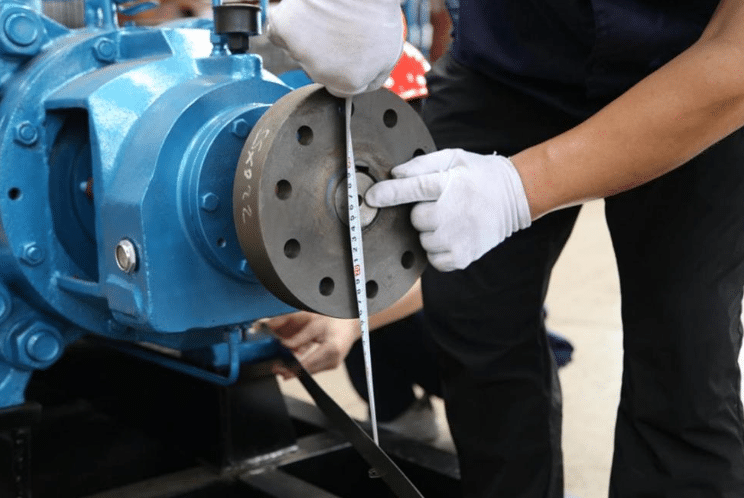Pump Alignment
In the world of industrial and mechanical systems, pumps are vital components that ensure the continuous flow of fluids in various applications, from water treatment plants to oil refineries. However, even the most advanced and robust pump systems can experience failures or inefficiencies if not properly aligned with their drivers. Pump alignment is often overlooked, yet it is one of the most critical maintenance tasks that can significantly impact the longevity and performance of your equipment.
What’s pump alignment?
Pump alignment refers to ensuring that the pump and its driver (such as a motor or engine) are correctly positioned so that their shaft centerlines are collinear. In simpler terms, the goal is to align the shafts of the pump and driver along the same line to minimize any misalignment that could cause operational issues.

The Importance of the Right Pump Pairing
- Reduces wear and tear: Misalignment can cause excessive wear on bearings, seals, couplings, and shafts, leading to premature failure and costly repairs.
- Minimizes vibration and noise: Misaligned pumps often create vibrations and noise, which can be disruptive and even dangerous in some settings.
- Increases energy efficiency: Proper alignment reduces frictional losses, which means the pump operates more efficiently, consuming less power.
- Prevents unplanned downtime: Regular alignment checks can prevent unexpected breakdowns, thus avoiding costly downtime and maintenance.
Type Of Pump Centering
Understanding the different types of misalignment is key to diagnosing and correcting alignment issues effectively:
- Angular Misalignment: Occurs when the shafts of the pump and driver are at an angle to each other. The shafts are not parallel, causing a non-uniform gap between the coupling faces.
- Offset (Parallel) Misalignment: Happens when the shafts are parallel but not collinear. This means the centerlines of the pump and driver are offset, leading to horizontal or vertical displacement between the shafts.
- Combined Misalignment: In many real-world scenarios, angular and offset misalignment can occur, requiring a more complex adjustment process.
Common Methods of Pump Alignment
Several methods can be used to align a pump and its driver, ranging from basic manual techniques to advanced digital tools:
Straightedge and Feeler Gauge: This traditional method uses a straightedge (a flat, rigid bar) and a set of feeler gauges to check the gap between the coupling faces. While this method is cost-effective, it is less accurate and requires a high level of skill.
Dial Indicator Method: A more precise method involves using a dial indicator to measure the runout at multiple points around the coupling. By rotating the shafts and taking readings at different positions, you can determine the degree of misalignment. This method provides better accuracy than the straightedge method but can still be time-consuming.
Laser Alignment: The most modern and accurate method, laser alignment tools use laser beams and digital sensors to measure shaft alignment. The tool provides a digital readout of the exact misalignment values in both angular and offset dimensions. Laser alignment is fast, highly precise, and easy to document, making it the preferred method in most industrial settings.
How do I fix a misaligned pump?
Fixing pump misalignment (i.e., alignment issues between the pump and its driver, such as a motor or engine) involves several steps to ensure the shafts of the pump and driver are properly realigned. Here is a detailed guide on how to fix pump misalignment:
Steps to Fix Pump Misalignment
Preparation
- Ensure Safety: Before performing any maintenance work, ensure that the pump system is shut down, locked out, and tagged to prevent accidental startup. Make sure the equipment is de-energized and free from all hazards.
- Inspect Equipment Condition: Check the condition of the pump and its driver, including bearings, seals, couplings, etc., for any visible damage or wear. These issues should be resolved before attempting realignment.
- Measure Initial Alignment Condition: Use appropriate alignment tools (such as a dial indicator or laser alignment tool) to measure the current alignment condition and determine whether there is angular misalignment, parallel (offset) misalignment, or combined misalignment.
Check for Soft Foot
- Check for Soft Foot Issues: Soft foot occurs when one or more feet of the pump or motor are not in full contact with the baseplate. This can affect the alignment results. Use a feeler gauge to check for gaps between each foot and the baseplate.
- Correct Soft Foot Issues: Loosen the mounting bolts of the pump or motor and then tighten them one by one, observing any changes in the dial indicator readings. If changes are detected, soft foot is present. Correct the issue by adjusting the shims or re-mounting to ensure all feet are in full contact with the baseplate.
Rough Alignment
- Perform Initial Alignment with a Straightedge and Feeler Gauge: Use a straightedge and feeler gauge to check the alignment of the coupling in both horizontal and vertical directions. This is a basic step to get a general idea of the misalignment.
- Loosen Mounting Bolts: Loosen the mounting bolts of the pump or motor to allow for movement to make initial adjustments.
- Move the Pump or Driver: Use tools like pry bars or jacks to move the pump or driver to roughly align the shafts.
Precision Alignment
- Use a Dial Indicator or Laser Alignment Tool: Choose more precise tools, such as a dial indicator or laser alignment tool, for accurate alignment. A laser alignment tool provides quick and accurate readings to identify specific data on angular and offset misalignment.
- Adjust Shim Thickness: Based on the measurements, add or remove shims under the base of the pump or driver to adjust the vertical height and horizontal position. Make small adjustments until the dial indicator or laser alignment tool shows readings within the required tolerance.
- Adjust Horizontal and Vertical Directions: When performing precise alignment, adjust for both horizontal and vertical offsets separately to ensure the pump and driver shafts are perfectly aligned.
Recheck and Verify Alignment
- Tighten Bolts and Re-measure: After completing the adjustments, tighten all the mounting bolts to the manufacturer’s recommended torque specifications. Then, use the alignment tool again to recheck the alignment and ensure no displacement occurred during tightening.
- Check Final Alignment Results: Ensure that the readings from the laser alignment tool or dial indicator are within the manufacturer’s specified tolerance range.
Record and Maintain
- Document Alignment Data: Record the final alignment data, tools used, shim thickness, and any adjustments made for future reference and maintenance.
- Regular Maintenance and Monitoring: Regularly check the pump’s alignment, especially after changes in environmental conditions or equipment movement. Use vibration analysis and other monitoring tools to detect potential alignment issues early.
Common Pump Alignment Tools
- Straightedge and Feeler Gauge: Used for initial checks and rough alignment but with lower precision.
- Dial Indicator: Used to measure shaft runout and axial movement with moderate precision, requiring some operational skills.
- Laser Alignment Tool: The most precise and efficient alignment tool that can quickly provide data on angular and offset misalignment, suitable for most industrial applications.
Precautions for Fixing Pump Misalignment
- Avoid Forcing Adjustments: Avoid using excessive force to adjust the equipment’s position during the alignment process, as this can damage bearings or other components.
- Check Environmental Factors: Verify that external factors, such as pipe strain, foundation settling, or temperature changes, are not affecting the equipment alignment.
- Ensure Stable Foundation: The stability of the equipment foundation is crucial for maintaining alignment. Ensure the pump and driver are mounted on a solid foundation to prevent future misalignment.
Summary
Proper pump alignment is more than just a maintenance task; it’s an investment in equipment reliability, efficiency and longevity. By understanding the types of misalignment and using the right tools, you can ensure that your pump system runs smoothly and efficiently, reducing downtime and maximizing productivity.
AOBl pumps commitment to quality is evident in the manufacture of every pump. Utilizing premium materials and following strict quality control processes, they are able to withstand the most demanding environmental and application conditions. Whether you need centrifugal pumps, diaphragm pumps, chemical pumps, pulsation dampeners and filter regulating valves in pump accessories that can provide you with customized and professional solutions, AOBl has the expertise and product range to meet your specific needs. Feel free to contact us.

